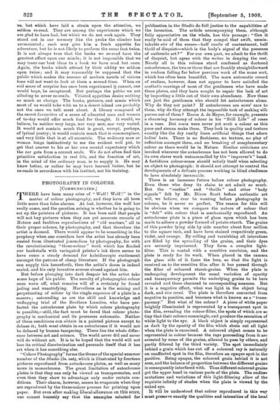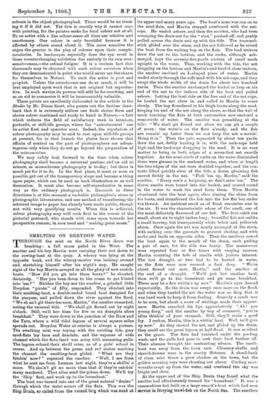T HERE have been many cries of " Wolf ! Wolf
!" in the
matter of colour photography, and they have all been little more than false alarms. At last, however, the wolf has really come, and the question arising is whether he is going to eat up the painters of pictures. It has been said that people will not buy pictures when they can get accurate records of Nature and faultless reproductions of "old masters," all in their proper colours, by photography, and that therefore the artist is doomed. There would appear to be something in the prophecy when one considers how the artist has already been meted from illustrated journalism by photography, for with the revolutionising " three-colour" work which has flooded our bookstalls with variegated printer's ink there seems to have come a steady demand for kaleidoscopic excitement amongst the patrons of cheap literature. If the photograph can supply this henceforth, then the artist's doom is indeed sealed, and his only lucrative avenue closed against him.
But before plunging into dark despair let the artist take some hope of his public. The novelty of photographic colour once worn off, what remains will of a certainty be found jading and unsatisfying. Marvellous as is the seizing and perpetuating of colour by the single exposure of a plate in a camera ; astounding as are the skill and • knowledge and unflagging trial of the Brothers Lumiere, who have per- fected the autochrome plate by which colour photography is possible,—still, the fact must be faced that colour photo- graphy is mechanical and its processes automatic. Neither of these conditions can obtain in a painted picture except to debase it; both must obtain in an autochrome if it would not be debased by human tampering. There lies the whole differ- ence between art and science. The world never did and never will do without art. It is to be hoped that the world will not lose its critical discrimination and persuade itself that it has art when it has something else.
" Colour Photography" forms the theme of the special summer number of the Studio (5s. net), which is illustrated by fourteen pictures reproduced from autochrome plates, as well as many more in monochrome. The great limitation of autochrome plates is that they can only be viewed as transparencies, and even then they show to advantage only under certain con- ditions. Their charm, however, seems to evaporate when they are reproduced by the three,colour process for printing upon paper. But even after reeking liberal allowance on this score, one cannot honestly say that the examples selected for publication in the Studio do full justice to the capabilities of the invention. The article accompanying them, although fully appreciative on the whole, has this passage : " Can it really be said of them that they compel that swift, unmis- takable stir of the senses—half rustle of contentment, half thrill of disquiet—which is the body's signal of the presence of authentic art ? " For our own part, we admit to the thrill of disquiet, but agree with the writer in denying the rest. Nearly all in this volume stand confessed as doctored autochromes, the two or three that are frankly straightforward in realism falling far below previous work of the same sort, which has often been beautiful. The mere automatic record of realism, however, does not appear to have satisfied the aesthetic cravings of most of the gentlemen who have made these plates, and they have sought to repair the lack of art by importing a little out of their own abundance. Now these are just the gentlemen who should let autochromes alone. Why do they not paint ? If autochromes are sows' ears to them, why do they attempt the impossible task of making silk purses out of them ? Baron A. de Meyer, for example, presents a charming harmony of colour in his " Still Life " of roses in a vase. But roses were never yet such a colour as this puce and sienna make them. They look in quality and texture exactly like the dry rustly linen artificial things that adorn ladies' hats. There is no fleshiness, no texture, no play of reflection amongst them, and no breaking of complementary colour as there would be in Nature. Similar criticisms are invoked wherever the autochrome has not been allowed to do its own clever work untrammelled by the " improver's " band. A fastidious colour-sense should satisfy itself when selecting an object to photograph: it should not attempt to control the developments of a delicate process working in blind obedience to laws absolutely inexorable.
There is an immense future before colour photography. Even those who deny its claim to art admit so much. But the "rustles" and "thrills " and other "body signals" felt by Mr. Dixon Scott before authentic art will, we believe, ever be wanting before photography in colours, be it never so perfect. The reason for this will be obvious when we compare the nature of colour that is "felt" with colour that is mechanically reproduced. An autochrome plate is a piece of glass upon which has been made to adhere a powder formed of potato-starch. The grains of this powder lying side by side number about four million to the square inch, and have been stained respectively green, violet, and orange. By rolling and varnishing all interstices are filled by the spreading of the grains, and their dyes are securely imprisoned. They form a complex light- filter. This is coated with a sensitive emulsion, and the plate is ready for its work. When placed in the camera the glass side of it faces the lens, so that the light is received on to the sensitive film after it has passed through the filter of coloured starch-grains. When the plate is undergoing development the usual variation of opacity and transparency permits the underlying grains to be here revealed and there obscured in corresponding nuances. But it is a negative effect, what was light in the object being dark, and vice versd. The plate is therefore converted from negative to positive, and becomes what is known as a " trans- parency." But what of the colour ? A piece of white paper brightly illuminated is represented by a transparent spot in the film, revealing the colour-filter, the spots of which are so tiny that their colours commingle, and produce the sensation of white light to the eye. A black object is simply represented as dark by the opacity of the film which shuts out all light when the plate is examined. A coloured object comes to be represented in colour because the rays proceeding from it are arrested by some of the grains, allowed to pass by others, and partly filtered by the third variety. The spot immediately behind a grain which has cut off a coloured ray is naturally an unaffected spot in the film, therefore an opaque spot in the positive. Being opaque, the coloured grain behind it is not seen, and the balance of proportion between the different grains is consequently interfered with. Thus different coloured grains get the upper band in various parts of the plate. The endless mutations and variations of this light-filtering allow of the requisite infinity of shades when the plate is viewed by the naked eye.
It will be understood that colour reproduced in this way must preserve exactly the qualities and intensities of the local
colours in the object photographed. There would be no trust- ing it if it did not. Yet this is exactly why it cannot cope with painting, for the painter seeks for local colour not at all. To an artist with a fine colour-sense all tints are relative and reactionary. One colour is only beautiful because it is affected by others round about it. The more sensitive the organ the greater is the play of colours upon their comple- mentaries. In landscapes especially does the eye revel in these counterchanging subtleties due entirely to its own over- sensitiveness,—the retinal fatigue. It is a curious fact that thousands may be charmed with such colour exercises when they are demonstrated in paint who would never see the charm for themselves in Nature. To such the artist is poet and prophet. Unless the autochrome can do as much, it will be best employed upon work that is not original but reproduc- tive. In such service its powers will still be far-reaching, and as an aid to commerce it will be immeasurably valuable.
These points are excellently elaborated in the article in the .Studio by Mr. Dixon Scott, who points out the further draw- back that it is extremely seldom one finds choice form and choice colour combined and ready to hand in Nature,—a fact which reduces the field of satisfactory work to interiors, portraits, or still-life groups, where the " autochromist" can be artist first and operator next. Indeed, the reputation of colour photography may be said to rest upon still-life groups at present, for in that branch the plates have shown that efforts of control on the part of photographers are advan- tageous only when they do not go beyond the preparation of the raise-en-scene.
We may safely look forward to the time when colour photography shall become a universal pastime and an aid to science, as monochrome photography is to-day; but there is much yet for it to do. In the first place, it must as soon as possible get out of the transparency stage and become a thing upon paper, which can be used as book illustration or as wall decoration. It must also become self-reproductive in some way as the ordinary photograph is. Research in these directions is at this moment a veritable philosopher's stone in photographic laboratories, and one method of transferring the coloured image to paper has already been made public, though not with very gratifying results. When this is achieved, colour photography may well rush first to the rescue of the pictorial postcard, who stands with arms open towards her prospective rescuer, in sore need and " making great moan."







































 Previous page
Previous page